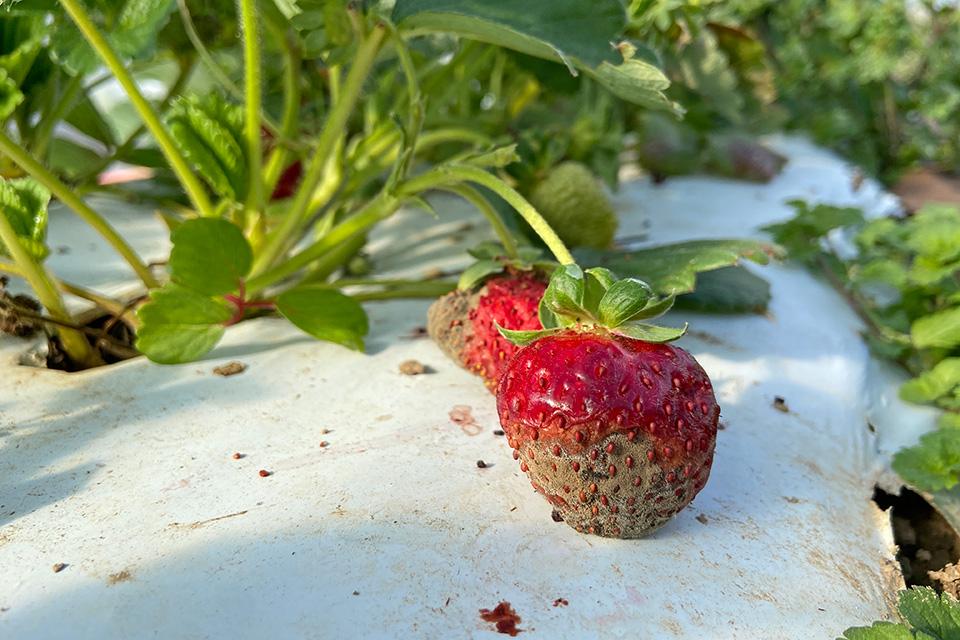Creative Solutions to Improve Water Quality

Eveh the best managed irrigation systems can be a source of runoff that can transport pesticides to downstream surface water bodies. Overhead sprinkler pipes frequently have leaks that contribute to runoff as the soil becomes saturated. Furrow irrigation also results in tail water because water applied to the top of a field usually does not uniformly advance down the furrows due to differences in slope or soil texture.
Consequently, growers generally collect furrow runoff water in a tail ditch at the lower end of their fields. In irrigation districts where flood irrigation is widely used, tail water returns may be reused for irrigation of farms located further downstream, or used to support aquatic habitat in rivers, creeks, or wetlands.
Pesticides carried in agricultural runoff potentially damage aquatic organisms. Several methods of treating runoff on farms do offer promise for reducing potential pesticide toxicity in surface water. With stricter water quality regulations being implemented in California, many growers are giving these practices a try.
Successful Settlement
Collecting runoff in retention basins or sediment traps can potentially settle out a large fraction of pesticides attached to suspended sediments, such as pyrethroids. The success of these settling practices depends on the water chemistry, basin dimensions, and treatment time. Finely suspended particles will require more time to settle than larger particles. Also, sediments may drop out faster in water with naturally higher concentrations of divalent cations, such as calcium and magnesium.
Sediment traps are designed for removing large-sized particles in runoff that settle out quickly when the flow rate of the runoff slows. Traps are designed for short residence time (less than 30 minutes) and are usually shallow basins that can be easily cleaned out as they fill with sediment. Retention basins are designed to hold a sufficient volume of runoff to provide several days of residence time so that fine sediments can settle to the bottom. The longer residence time also provides time for pesticides to break down.
The Role Of Polymers
The use of polymers is another practice that can be used to treat pesticides that strongly bind to sediments in runoff. Adding anionic polyacrylamide (PAM) to irrigation water can greatly reduce sediment loads in runoff (Fig. 1). Past research has demonstrated that pyrethroid concentrations were reduced by more than 90% in both furrow and sprinkler induced runoff by adding low concentrations (5 ppm) of PAM to the irrigation water. Liquid formulations of PAM can be injected into pressurized irrigation systems, while granular dry PAM can be added directly to furrow water.
While polymers may help with pesticides that bind to sediments, they do not provide much benefit for pesticides that are very soluble.
CSIRO, the Australian federal research agency, has developed an enzyme product which can be added directly to runoff water and breakdown organophosphate pesticides such as chlorpyrifos and diazinon to non-toxic metabolites. Although preliminary trials in California have shown that the product is very effective, it is not widely available yet and may initially be expensive to use.
Other Ways To Reduce Toxins
Vegetated waterways, vegetated treatment systems, and constructed wetlands, are other means of treating pesticides in runoff (Fig. 2). These practices have varying levels of success in reducing the concentration of toxins, depending on the type and concentration of pesticides, residence time of the water, and composition of plant species. If optimized, the physical and chemical processes that occur in vegetated treatment systems can be effective in metabolizing pesticides. In most cases where vegetated practices have been successful, the residence time of the water was at least several days. A multi-day residence period may require a large treatment area depending on the volume of runoff.
In the absence of the ability to treat runoff, finding ways to dispose of tail water on a farm may be the next cheapest solution. A common practice on the Central Coast was to capture tail water in retention ponds at the low end of the ranch and reuse the water for pre-irrigations and germination of crops, as well as dust abatement of roads.
Unfortunately, because of food safety concerns on farms where leafy greens are produced, reusing tail water is usually not permitted by produce buyers. In this situation, land may need to be set aside for disposing of captured runoff. Runoff can be diverted to pastures or grassed buffer areas between fields and roadways or ditches.
The Use Of Vegetation
Another option is to develop a vegetated water way for both treating and disposing of runoff. By widening and grading a drainage ditch to a shallow slope, and vegetating it with grasses, drip lines can be used to apply runoff water to the sides of the ditch (Fig. 3). The grasses are able to take up much of the applied water to meet transpiration needs, and excess water flowing down the sides has more time to interact with the vegetation than water applied directly to the bottom of the ditch.
As one can imagine from the solutions outlined, many possible methods could be used for mitigating pesticides in irrigation runoff. Unfortunately, most of these practices can increase costs for farmers either through capital investments in irrigation equipment, more intensive management of existing irrigation systems, or costs associated with treatment and disposal methods.
Growers have always been able to find creative solutions to meet economic challenges. With clear and reasonable targets for water quality, I am optimistic that growers can achieve improved water quality in the upcoming years.








